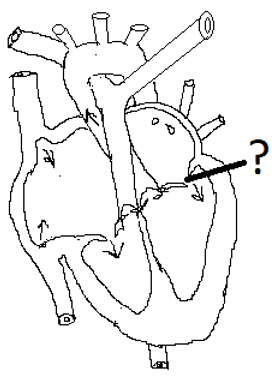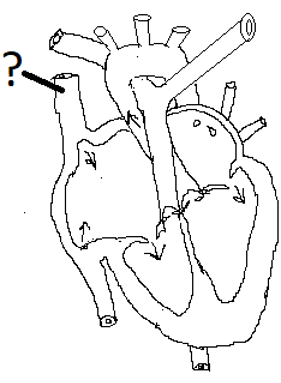This set of Class 11 Biology Multiple Choice Questions & Answers (MCQs) focuses on “Human Circulatory System – 2” for AIIMS Exam.
1. Identify the valve of the heart.

a) Pulmonary semilunar valve
b) Aortic semilunar valve
c) Tricuspid valve
d) Bicuspid valve
View Answer
Explanation: In the given diagram of the cross section of the heart, the indicated valve is the bicuspid valve. It is also known as the mitral valve. The bicuspid valve is the opening between the left auricle and left ventricle.
2. Identify the blood vessel of the heart.

a) Aorta
b) Pulmonary artery
c) Superior vena cava
d) Pulmonary aorta
View Answer
Explanation: In the given diagram of the cross-section of the heart, the indicated structure is the superior vena cava. The superior vena cava delivers deoxygenated blood from the upper parts of the body to the heart.
3. In the joint diastole state, which of these events do not occur?
a) All four chambers are relaxed
b) Both tricuspid and bicuspid valves are open
c) Blood from pulmonary vein flows into the right atrium
d) Both semilunar valves are closed
View Answer
Explanation: In the joint diastole state, all four chambers of the heart are relaxed. The tricuspid and bicuspid valves are open while the semilunar valves are closed. Blood from pulmonary vein flows into the left ventricle.
4. Which of these occurs during the atrial systole?
a) Both atria contract simultaneously
b) Action potential is generated by the AVN initially
c) Tricuspid valve closes
d) The semilunar valves remain open
View Answer
Explanation: During the atrial systole, both the atria contract simultaneously while the ventricles remain relaxed. It occurs due to the action potential generated by the SAN. The tricuspid and bicuspid valves open.
5. During atrial systole, blood flow toward the ventricles increases by what percent?
a) 10%
b) 30%
c) 50%
d) 70%
View Answer
Explanation: During the atrial systole, both the atria contract simultaneously while the ventricles remain relaxed. The increase in pressure in the atria forces 30% more blood to flow into the ventricles.
6. Which structure is not responsible for the transmission of action potential to the ventricles?
a) AV bundle
b) AVN
c) SAN
d) Bundle of His
View Answer
Explanation: SAN or the sinoatrial node is auto excitable and is responsible for generating the action potential. This action potential is transmitted to the ventricles via the AVN, the AV bundle and the Bundle of His.
7. Which of these events coincide with ventricular systole?
a) Atrial diastole
b) Atrial systole
c) Joint diastole
d) Ventricular diastole
View Answer
Explanation: The relaxation of the atria or the atrial diastole coincides with the contraction of the ventricles or the ventricular systole. The right and left semilunar valves open up due to the increase in pressure in the ventricles.
8. Which of these events do not occur during ventricular systole?
a) Closure of tricuspid and bicuspid valves
b) Atrial diastole
c) Opening of the semilunar valves
d) Flow of blood from atria to ventricles
View Answer
Explanation: During ventricular systole or the contraction of the ventricles, the tricuspid and bicuspid valves close and the semilunar valves open. The atrial diastole occurs at the same time as the ventricular systole.
9. What happens when the ventricular pressure decreases?
a) Blood from pulmonary artery flows into ventricle
b) The semilunar valves remain open
c) The tricuspid and bicuspid valves open
d) Atrial pressure decreases
View Answer
Explanation: The ventricular pressure decreases during the ventricular diastole or when the ventricles relax. The tricuspid and bicuspid valves open to allow blood to flow from the atria to the ventricles.
10. The first heart sound occurs due to the closure of the semilunar valves. True or false?
a) True
b) False
View Answer
Explanation: Two distinct heart sounds are audible with the help of the stethoscope. The first heart sound occurs due to the simultaneous closure of the bicuspid valve and the tricuspid valve. It is heard as a ‘lub’.
11. What is the approximate duration of a cardiac cycle?
a) 0.1 seconds
b) 72 seconds
c) 1 minute
d) 0.8 seconds
View Answer
Explanation: We know that the heart beats 70-75 times per minute. It beats approximately 72 times per minute. Hence, 72 cardiac cycles take place in one minute. Therefore, the duration of one cardiac cycle is 0.8 seconds.
12. What is the approximate stroke volume?
a) 250 ml
b) 5000 ml
c) 70 ml
d) 500 ml
View Answer
Explanation: 72 cardiac cycles take place in one minute. The duration of one cardiac cycle is 0.8 seconds. During each cardiac cycle, each of the two ventricles pump 70 ml of blood, which is known as the stroke volume.
13. What is the formula for cardiac output?
a) Stroke volume – heart rate
b) Stroke volume + heart rate
c) Stroke volume × heart rate
d) Stroke volume / heart rate
View Answer
Explanation: Cardiac output is the product of the stroke volume and the heart rate. It is the total amount of blood pumped by each ventricle per minute. The average cardiac output of a healthy adult is 5000ml.
14. What is the average cardiac output for a healthy individual?
a) 5000 ml
b) 70 ml
c) 500 ml
d) 1000 ml
View Answer
Explanation: The average cardiac output of a healthy adult is 5000ml or 5 liters. This means that if the heart rate is 72 beats per minute and the stroke volume is 70ml, then around 5000ml of blood is pumped by each ventricle in one minute.
15. Which of these devices is used to hear the heart sounds?
a) Endoscope
b) Stethoscope
c) Sphygmomanometer
d) Electrocardiograph
View Answer
Explanation: The heart makes two distinct sounds, termed ‘lub’ and ‘dub’, which can be audible to the human ear with the help of an instrument known as the stethoscope. These sounds are important for clinical diagnoses.
Sanfoundry Global Education & Learning Series – Biology – Class 11.
To practice all chapters and topics of class 11 Biology for AIIMS Exam, here is complete set of 1000+ Multiple Choice Questions and Answers.
If you find a mistake in question / option / answer, kindly take a screenshot and email to [email protected]
- Practice Class 12 - Biology MCQs
- Practice Class 11 - Mathematics MCQs
- Check Class 11 - Books
- Practice Class 11 - Physics MCQs
- Practice Class 11 - Chemistry MCQs
